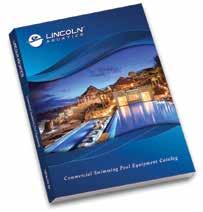
2 minute read
Applying Inclusivity to Aquatic Policies and Practices
By Kate Connell, CPRP, AFO
As aquatic facility operators, there is no argument that the way we plan for, build and manage aquatic facilities has a direct impact on accessibility. Inclusive aquatics, on the other hand, occurs beyond multimillion-dollar capital improvement projects and adherence to accessibility laws and codes. Inclusivity objectives are met minute by minute as we execute our decision-making skills as pool operators and aquatic programmers. They are measured by not only what we do and decide, but also what we don’t prioritize.
Advertisement
The three Ps of inclusive aquatics include: policies, programming and personnel.
Policies Most policies and procedures are implemented in an aquatics environment with safety in mind. But, it’s important to study your policies with an inclusivity-focused lens. If your swim test requires competence in treading and stroke refinement, do you have solutions? These could include offering swim scholarships, lessons during school or camp programming hours, transportation opportunities, parent education or discounts for lowincome residents, since cost often is a barrier that keeps many youths from learn-to-swim programs. If everyone is required to shower before entering your bodies of water, do you provide safe and welcoming spaces for non-binary individuals? Do you offer alternatives to assisted changing rooms for adults with disabilities if your facility doesn’t have singlestall showers? Use these potential barriers as a scorecard against each of your existing and potential policies to truly measure their exclusivity: • Cost • Language • Proximity • Process • Education level • Physical • Experience level requirements
Programming Aquatic programming can extend far beyond swim lessons and water fitness classes. Often, we first need to look at what we do most and how we can reach more individuals. With a focus on inclusion, aquatic facility operators can look for opportunities to remove barriers from existing programming and to conceive new ways to actively invite community members into aquatic recreation instead of passively waiting for them to join in: • Remove barriers from new and existing programming (see above list). • Reconsider gender and holiday conforming programming. • Visually represent diversity and alternative languages in marketing imagery and text. • Create a list of community partners and address their needs. • Program in free and walkable spaces, like splash pads and wading pools. • Focus on basic recreation opportunities. • Create cross-sectional programs
with other departments. • Find a team of true fans who will share your mission. • Consider accessibility and impact during various times and days of offerings.
Personnel As recreation professionals, it’s important to be aware of our own inherent biases, to be responsible to our aquatic facilities and communities, and to work on developing our personal and organization missions toward inclusivity. As operators, many of us manage a diverse staff and have a responsibility to ensure that these staff members are trained on how our personal privileges can impact our interactions with others. Work with your team to teach them the significance of: • Protected classes and their rights • Word use and choice • Implicit biases • Microaggressions
Above all, consciously build and recruit a staff that looks, acts and has experiences that are representative of the community where they work. And, give your employees tangible tools that relate what they do to an inclusive mission.
As park and rec professionals, our commitment to inclusive aquatic spaces can make a profound impact in our communities for generations to come.
Kate Connell, CPRP, AFO, is Aquatics Program Supervisor at Iowa City Parks and Recreation Department (katherine-connell@ iowa-city.org).










